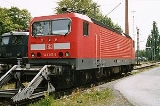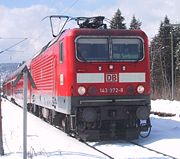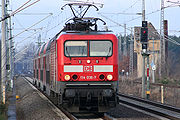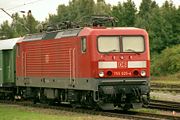
DR Class 243
Encyclopedia
The DR Class 243 is a universal electric locomotive
of the Deutsche Reichsbahn which is used for general rail service. Deutsche Bahn
lists the locomotive as Class 143. The locomotives of class 143/243 still belong to the most successful class of German electric locomotives.
 Since 1980 the Deutsche Reichsbahn of the GDR
Since 1980 the Deutsche Reichsbahn of the GDR
started increasing track electrification due to rising oil prices. Before that the DR had mainly used locomotives driven by Russian diesel fuel. VEB Lokomotivbau und Elektrotechnische Werke Hennigsdorf
, the only manufacturer of electric locomotives in the GDR, received the order to develop, a lighter, four-axle and technically modern electric locomotive for passenger transport and medium cargo service based on the heavy cargo locomotive DR Class 250
. The mechanical components were developed and produced in Hennigsdorf. The electric motors were manufactured by EMW Dresden
.
The prototype locomotive 212 001 was built in 1982 and presented to the public in the same year with a designed maximum speed of 140 kilometres per hour (87 mph). It did several testing before it was modified in order to operate at a maximum speed of 120 km/h (74.6 mph) with also changing the number to 243 001.
Because of its special painting (white with red stripes), 243 001 was given the nickname Weiße Lady (White Lady).
The production of the series was started in 1985 after the testing with 243 001 was successful.
Locomotives manufactured from 1987 (from 143 302) were equipped with a more streamlined front, which reduced energy consumption by about 5% by reducing air resistance.
From 1988 the Class 243.8 locomotives received multiple-unit train control
equipment. Subsequently 109 locomotives without multiple unit train control were acquired up to December 1990, so that the DR had in total 636 Class 243 locomotives at their disposal. 243 659 was the final Class 243 locomotive enter service on 2 January 1991.
After German reunification
goods traffic in the former East Germany came to a standstill and many Class 243 locomotives stood on sidings with no work. From August 1990 locomotive 243 922 (later DB 143 922) was hired to the Südostbahn
(Swiss South-Eastern Railway). Others went to Freiburg und Düsseldorf
for testing by Deutsche Bundesbahn
.
 The following year more locomotives were moved to the west where they were used on the Schwarzwaldbahn
The following year more locomotives were moved to the west where they were used on the Schwarzwaldbahn
, the Höllentalbahn, the Rhein-Ruhr S-Bahn
and goods trains from Dortmund. After the DB and DR were combined in 1994 to form Deutschen Bahn AG the Class 143 locomotives were used on many more lines in the former West Germany
.
The former 212 001 remained the property of LEW and after testing by the DR from 1982 to 1984 was used for various measuring and experimental tasks. In 2002 it was sold to EKO-Trans and (now numbered 143 001) was painted in their red and silver livery. In May 2008 143 001 was repainted orange with the logo of its new owner, Arcelor Mittal.
Six Class 143 locomotives (041, 069, 186, 191, 286, 874) have been sold to Bahn- und Hafenbetriebe der Ruhrkohle AG and a further six (179, 204, 257, 344, 851, 864) to Mitteldeutsche Eisenbahn Gesellschaft (MEG) where they have been renumbered as MEG 601-606.
and Regional-Express services, so the maximum speed of 120 km/h was awkward, especially as the carriages often had a maximum speed of 140 or 160 km/h. It was planned to rebuild some locomotives with higher maximum speeds of 140 and 160 km/h, which would be classified as Class 114.3 and Class 114.1 respectively.
143 171 was rebuilt with a maximum speed of 160 km/h and renumbered as 114 101. During the rebuilding the pantograph
was replaced with a newer model of type SSS 87 and the train protection system and brake equipment were adapted for higher speeds. The gear ratio
between the motors and wheels was also changed and dampers were fitted between the locomotive body and the bogies.
143 120 was rebuilt into 114 301 with a maximum speed of 140 km/h. This did not require changes to the gear ratio or the fitting of dampers.
Both rebuilt locomotives were tested in test service and normal use around Magdeburg. The upgrading to 160 km/h cost € 300,000 per locomotive and upgrading to 140 km/h cost € 48,000 per locomotive. For this reason only speed increases to 140 km/h have followed.
were rebuilt with a maximum speed of more than 120 km/h. The Deutsche Reichsbahn had no locomotives capable of this speed so it had to acquire new faster locomotives. However, the Class 212 locomotives had originally been designed with a maximum speed of 160 km/h. After four prototype locomotives (numbered 212 002 to 212 005, the number 212 001 had originally been used for 143 001 and was not reused) a series of 35 locomotives (212 006 to 212 040) was delivered.
The Class 112 locomotives became an unexpected symbol of German reunification
because they were the first locomotive class to be used by both the Deutsche Reichsbahn
and the Deutsche Bundesbahn
. DR and DB each ordered 45 slightly improved locomotives of Class 112.1 from AEG
, who had taken over LEW Hennigsdorf as they had owned the factory in 1946. The decision for DB to order Class 112.1 locomotives was mainly to support the factory at Hennigsdorf as DB would have preferred a 200 km/h universal locomotive such as the Class 120
.
After overcoming a few initial problems the Class 112 were mainly used on InterRegio
trains. In 1995, 112 025 (the former 212 025) was renumbered as test locomotive 755 025. Following the end of InterRegio services and the upgrading of Regional-Express rolling stock for speeds of 140 km/h and 160 km/h the Class 112 locomotives are used predominantly for regional services. On 1 January 2004 DB Fernverkehr
transferred all its Class 112.1 locomotives to DB Regio
.
 All 38 locomotives of Class 112.0 were reclassified as Class 114 on 1 April 2000 because up to this time these locomotives had been used exclusively for regional trains in Berlin, Brandenburg and Mecklenburg-Vorpommern and there were several differences between these locomotives and the Class 112.1. Following the transfer of the remaining Class 112 locomotives to DB Regio the reason for the different classifications is unnecessary as there are similar differences between locomotives within Class 143.
All 38 locomotives of Class 112.0 were reclassified as Class 114 on 1 April 2000 because up to this time these locomotives had been used exclusively for regional trains in Berlin, Brandenburg and Mecklenburg-Vorpommern and there were several differences between these locomotives and the Class 112.1. Following the transfer of the remaining Class 112 locomotives to DB Regio the reason for the different classifications is unnecessary as there are similar differences between locomotives within Class 143.
 The VES-M Halle
The VES-M Halle
(Research Institute Halle) needed a fast electric locomotive for their measuring and test trains. In January 1995 they received 112 025 which was renumbered 755 025. Today it is numbered 114 501.
Electric locomotive
An electric locomotive is a locomotive powered by electricity from overhead lines, a third rail or an on-board energy storage device...
of the Deutsche Reichsbahn which is used for general rail service. Deutsche Bahn
Deutsche Bahn
Deutsche Bahn AG is the German national railway company, a private joint stock company . Headquartered in Berlin, it came into existence in 1994 as the successor to the former state railways of Germany, the Deutsche Bundesbahn of West Germany and the Deutsche Reichsbahn of East Germany...
lists the locomotive as Class 143. The locomotives of class 143/243 still belong to the most successful class of German electric locomotives.
Development

Deutsche Reichsbahn of the GDR
The Deutsche Reichsbahn or DR was the operating name of state owned railways in the German Democratic Republic ....
started increasing track electrification due to rising oil prices. Before that the DR had mainly used locomotives driven by Russian diesel fuel. VEB Lokomotivbau und Elektrotechnische Werke Hennigsdorf
LEW Hennigsdorf
The rail vehicle factory in Hennigsdorf, Germany was founded in 1910 by AEG. Locomotive production began in 1913, and in the 1930s absorbed the work of the August Borsig locomotive factory, being renamed the Borsig Lokomotiv Werke GmbH until 1944...
, the only manufacturer of electric locomotives in the GDR, received the order to develop, a lighter, four-axle and technically modern electric locomotive for passenger transport and medium cargo service based on the heavy cargo locomotive DR Class 250
DR Class 250
The Deutsche Reichsbahn Class 250 is a German electric locomotive used on freight trains. Nicknamed the “Electric Container” or “Powercontainer” due to its distinctive carbody shape. The less favorable nickname “Stasi-Container” is also heard every now and then...
. The mechanical components were developed and produced in Hennigsdorf. The electric motors were manufactured by EMW Dresden
Dresden
Dresden is the capital city of the Free State of Saxony in Germany. It is situated in a valley on the River Elbe, near the Czech border. The Dresden conurbation is part of the Saxon Triangle metropolitan area....
.
The prototype locomotive 212 001 was built in 1982 and presented to the public in the same year with a designed maximum speed of 140 kilometres per hour (87 mph). It did several testing before it was modified in order to operate at a maximum speed of 120 km/h (74.6 mph) with also changing the number to 243 001.
Because of its special painting (white with red stripes), 243 001 was given the nickname Weiße Lady (White Lady).
The production of the series was started in 1985 after the testing with 243 001 was successful.
DR Class 243
In 1985 there were no parts of the DR network on which speeds over 120 kilometres per hour (74.6 mph) were permitted, so large numbers of Class 243 locomotives were acquired. In 1984 the first 20 were delivered, followed by 80 in 1985, 100 in 1986, 110 in 1987 and 114 in 1988. At the end of 1989 the 500th locomotive was completed.Locomotives manufactured from 1987 (from 143 302) were equipped with a more streamlined front, which reduced energy consumption by about 5% by reducing air resistance.
From 1988 the Class 243.8 locomotives received multiple-unit train control
Multiple-unit train control
Multiple-unit train control, sometimes abbreviated to multiple-unit or MU, is a method of simultaneously controlling all the traction equipment in a train from a single location, whether it is a Multiple unit comprising a number of self-powered passenger cars or a set of locomotives.A set of...
equipment. Subsequently 109 locomotives without multiple unit train control were acquired up to December 1990, so that the DR had in total 636 Class 243 locomotives at their disposal. 243 659 was the final Class 243 locomotive enter service on 2 January 1991.
After German reunification
German reunification
German reunification was the process in 1990 in which the German Democratic Republic joined the Federal Republic of Germany , and when Berlin reunited into a single city, as provided by its then Grundgesetz constitution Article 23. The start of this process is commonly referred by Germans as die...
goods traffic in the former East Germany came to a standstill and many Class 243 locomotives stood on sidings with no work. From August 1990 locomotive 243 922 (later DB 143 922) was hired to the Südostbahn
Südostbahn
The Südostbahn – commonly abbreviated to SOB – is a railway company and network in Switzerland.- Structure :...
(Swiss South-Eastern Railway). Others went to Freiburg und Düsseldorf
Düsseldorf
Düsseldorf is the capital city of the German state of North Rhine-Westphalia and centre of the Rhine-Ruhr metropolitan region.Düsseldorf is an important international business and financial centre and renowned for its fashion and trade fairs. Located centrally within the European Megalopolis, the...
for testing by Deutsche Bundesbahn
Deutsche Bundesbahn
The Deutsche Bundesbahn or DB was formed as the state railway of the newly established Federal Republic of Germany on September 7, 1949 as a successor of the Deutsche Reichsbahn-Gesellschaft '...
.
DBAG Class 143

Schwarzwaldbahn (Baden)
----The Baden Black Forest Railway is a twin-track, electrified railway line in Baden-Württemberg, Germany, running in a NW-SE direction to link Offenburg on the Rhine Valley Railway with Singen on the Upper Rhine Railway...
, the Höllentalbahn, the Rhein-Ruhr S-Bahn
Rhein-Ruhr S-Bahn
The Rhine-Ruhr S-Bahn is a polycentric S-Bahn network covering the Rhine-Ruhr Metropolitan Region in the German federal state of North Rhine-Westphalia. This includes most of the Ruhr , the Berg cities of Wuppertal and Solingen and parts of the Rhineland...
and goods trains from Dortmund. After the DB and DR were combined in 1994 to form Deutschen Bahn AG the Class 143 locomotives were used on many more lines in the former West Germany
West Germany
West Germany is the common English, but not official, name for the Federal Republic of Germany or FRG in the period between its creation in May 1949 to German reunification on 3 October 1990....
.
The former 212 001 remained the property of LEW and after testing by the DR from 1982 to 1984 was used for various measuring and experimental tasks. In 2002 it was sold to EKO-Trans and (now numbered 143 001) was painted in their red and silver livery. In May 2008 143 001 was repainted orange with the logo of its new owner, Arcelor Mittal.
Six Class 143 locomotives (041, 069, 186, 191, 286, 874) have been sold to Bahn- und Hafenbetriebe der Ruhrkohle AG and a further six (179, 204, 257, 344, 851, 864) to Mitteldeutsche Eisenbahn Gesellschaft (MEG) where they have been renumbered as MEG 601-606.
DBAG Class 114.1 and 114.3
Many Class 143 locomotives were in use for passenger traffic and on longer RegionalbahnRegionalBahn
The Regionalbahn is a type of local passenger train in Germany.-Service:Regionalbahn trains usually call at all stations on a given line, with the exception of RB trains within S-Bahn networks, these may only call at selected stations...
and Regional-Express services, so the maximum speed of 120 km/h was awkward, especially as the carriages often had a maximum speed of 140 or 160 km/h. It was planned to rebuild some locomotives with higher maximum speeds of 140 and 160 km/h, which would be classified as Class 114.3 and Class 114.1 respectively.
143 171 was rebuilt with a maximum speed of 160 km/h and renumbered as 114 101. During the rebuilding the pantograph
Pantograph (rail)
A pantograph for rail lines is a hinged electric-rod device that collects electric current from overhead lines for electric trains or trams. The pantograph typically connects to a one-wire line, with the track acting as the ground wire...
was replaced with a newer model of type SSS 87 and the train protection system and brake equipment were adapted for higher speeds. The gear ratio
Gear ratio
The gear ratio of a gear train is the ratio of the angular velocity of the input gear to the angular velocity of the output gear, also known as the speed ratio of the gear train. The gear ratio can be computed directly from the numbers of teeth of the various gears that engage to form the gear...
between the motors and wheels was also changed and dampers were fitted between the locomotive body and the bogies.
143 120 was rebuilt into 114 301 with a maximum speed of 140 km/h. This did not require changes to the gear ratio or the fitting of dampers.
Both rebuilt locomotives were tested in test service and normal use around Magdeburg. The upgrading to 160 km/h cost € 300,000 per locomotive and upgrading to 140 km/h cost € 48,000 per locomotive. For this reason only speed increases to 140 km/h have followed.
DR Class 212 to DBAG Class 112
Following German reunification, the rail routes to BerlinBerlin
Berlin is the capital city of Germany and is one of the 16 states of Germany. With a population of 3.45 million people, Berlin is Germany's largest city. It is the second most populous city proper and the seventh most populous urban area in the European Union...
were rebuilt with a maximum speed of more than 120 km/h. The Deutsche Reichsbahn had no locomotives capable of this speed so it had to acquire new faster locomotives. However, the Class 212 locomotives had originally been designed with a maximum speed of 160 km/h. After four prototype locomotives (numbered 212 002 to 212 005, the number 212 001 had originally been used for 143 001 and was not reused) a series of 35 locomotives (212 006 to 212 040) was delivered.
The Class 112 locomotives became an unexpected symbol of German reunification
German reunification
German reunification was the process in 1990 in which the German Democratic Republic joined the Federal Republic of Germany , and when Berlin reunited into a single city, as provided by its then Grundgesetz constitution Article 23. The start of this process is commonly referred by Germans as die...
because they were the first locomotive class to be used by both the Deutsche Reichsbahn
Deutsche Reichsbahn
Deutsche Reichsbahn was the name of the following two companies:* Deutsche Reichsbahn, the German Imperial Railways during the Weimar Republic, the Third Reich and the immediate aftermath...
and the Deutsche Bundesbahn
Deutsche Bundesbahn
The Deutsche Bundesbahn or DB was formed as the state railway of the newly established Federal Republic of Germany on September 7, 1949 as a successor of the Deutsche Reichsbahn-Gesellschaft '...
. DR and DB each ordered 45 slightly improved locomotives of Class 112.1 from AEG
AEG
Allgemeine Elektricitäts-Gesellschaft was a German producer of electrical equipment founded in 1883 by Emil Rathenau....
, who had taken over LEW Hennigsdorf as they had owned the factory in 1946. The decision for DB to order Class 112.1 locomotives was mainly to support the factory at Hennigsdorf as DB would have preferred a 200 km/h universal locomotive such as the Class 120
DB Class 120
The DB Baureihe 120 is a class of electric locomotives operated by DB Fernverkehr in Germany.-Background and design:The locomotives' prototypes, delivered in 1979 , were one of the first electric locomotives with three-phase motors. They were based on experiences made in the 1970s with...
.
After overcoming a few initial problems the Class 112 were mainly used on InterRegio
InterRegio
The InterRegio is a train service seen in some European countries. Mostly they are trains that run "from region to region", as best described by Swiss Federal Railways.-Switzerland:...
trains. In 1995, 112 025 (the former 212 025) was renumbered as test locomotive 755 025. Following the end of InterRegio services and the upgrading of Regional-Express rolling stock for speeds of 140 km/h and 160 km/h the Class 112 locomotives are used predominantly for regional services. On 1 January 2004 DB Fernverkehr
DB Fernverkehr
DB Fernverkehr AG is a semi-independent division of Deutsche Bahn that operates long-distance passenger trains in Germany. It was founded in 1999 in the second stage of the privatisation of German Federal Railways under the name of DB Reise&Touristik and renamed in 2003.DB Fernverkehr operates all...
transferred all its Class 112.1 locomotives to DB Regio
DB Regio
DB Regio AG is a subsidiary of Deutsche Bahn which operates short and medium distance passenger train services in Germany, and operates light and heavy rail infrastructure in the United Kingdom.-Germany:...
.
DBAG Class 114

DBAG 755 025

VES-M Halle
The Versuchs- und Entwicklungsstelle Maschinenwirtschaft in Halle, Germany, was a railway research and development department working for the engineering head office of the Deutsche Reichsbahn in East Germany after the Second World War...
(Research Institute Halle) needed a fast electric locomotive for their measuring and test trains. In January 1995 they received 112 025 which was renumbered 755 025. Today it is numbered 114 501.
Sources
- Michael Dostal: Baureihen 112, 143: Moderne Elektrolokomotiven für ganz Deutschland. GeraMond, München 2000 ISBN 3-932785-50-9
- Gottfried Köhler: Neuentwickelte Ellok BR 212/243 für die DR. In: Modelleisenbahner. Nr. 7/Jahrgang 31/1982. transpress VEB Verlag für Verkehrswesen Berlin, , S. 4-6.
- Wolfgang Faust: Die neue Ellok in der Betriebserprobung. In: Modelleisenbahner. Nr. 10/Jahrgang 33/1984. transpress VEB Verlag für Verkehrswesen Berlin, , S. 4.
- Michael Gröbner: Baureihe 143. Im Führerstand. In: LOK MAGAZIN. Nr. 250/Jahrgang 41/2002. GeraNova Zeitschriftenverlag GmbH München, , S. 48-51.

